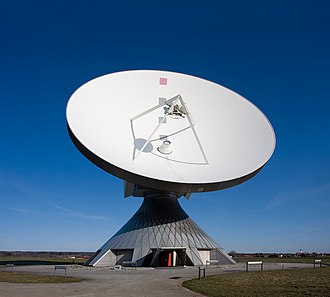
Back Telekommunikasie Afrikaans Telecomunicación AN اتصال عن بعد Arabic Telecomunicación AST Telekommunikasiya Azerbaijani Telekomunikasyon BCL Сувязь (тэхніка) Byelorussian Сувязь (тэхніка) BE-X-OLD Далекосъобщения Bulgarian ထာꩻဆှိုပ်စပ်ꩻ BLK

Telecommunication, often used in its plural form or abbreviated as telecom, is the transmission of information with an immediacy comparable to face-to-face communication. As such, slow communications technologies like postal mail and pneumatic tubes are excluded from the definition.[1][2] Many transmission media have been used for telecommunications throughout history, from smoke signals, beacons, semaphore telegraphs, signal flags, and optical heliographs to wires and empty space made to carry electromagnetic signals. These paths of transmission may be divided into communication channels for multiplexing, allowing for a single medium to transmit several concurrent communication sessions. Several methods of long-distance communication before the modern era used sounds like coded drumbeats, the blowing of horns, and whistles. Long-distance technologies invented during the 20th and 21st centuries generally use electric power, and include the telegraph, telephone, television, and radio.
Early telecommunication networks used metal wires as the medium for transmitting signals. These networks were used for telegraphy and telephony for many decades. In the first decade of the 20th century, a revolution in wireless communication began with breakthroughs including those made in radio communications by Guglielmo Marconi, who won the 1909 Nobel Prize in Physics. Other early pioneers in electrical and electronic telecommunications include co-inventors of the telegraph Charles Wheatstone and Samuel Morse, numerous inventors and developers of the telephone including Antonio Meucci, Philipp Reis, Elisha Gray and Alexander Graham Bell, inventors of radio Edwin Armstrong and Lee de Forest, as well as inventors of television like Vladimir K. Zworykin, John Logie Baird and Philo Farnsworth.
Since the 1960s, the proliferation of digital technologies has meant that voice communications have gradually been supplemented by data. The physical limitations of metallic media prompted the development of optical fibre.[3][4][5] The Internet, a technology independent of any given medium, has provided global access to services for individual users and further reduced location and time limitations on communications.
- ^ "Article 1.3" (PDF), ITU Radio Regulations, International Telecommunication Union, 2012, archived from the original (PDF) on 19 March 2015
- ^ Constitution and Convention of the International Telecommunication Union, Annex (Geneva, 1992)
- ^ "How does a Gigabit Passive Optical Network (GPON) work?". European Investment Bank. Archived from the original on 7 June 2021. Retrieved 7 June 2021.
- ^ Renewing U.S. Telecommunications Research. 2006. doi:10.17226/11711. ISBN 978-0-309-10265-0. Archived from the original on 23 June 2021. Retrieved 25 June 2021.
- ^ Cyphers, Bennett (16 October 2019). "The Case for Fiber to the Home, Today: Why Fiber is a Superior Medium for 21st Century Broadband". Electronic Frontier Foundation. Archived from the original on 3 June 2021. Retrieved 7 June 2021.